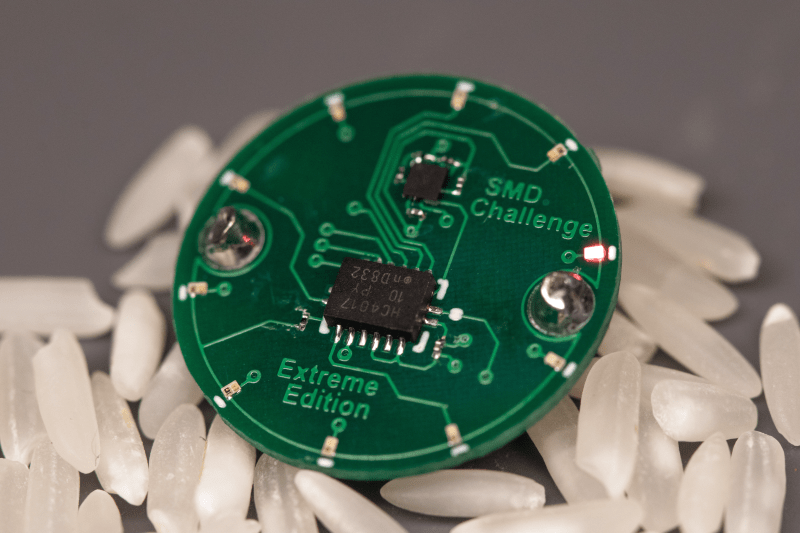Skills challenges have become a fun way to facilitate friendly competition amongst anyone who appreciates a fine solder joint. If you’ve seen any Supercon / Remoticon coverage there’s surely been a mention of the infamous soldering skills challenge, where competitors test their mettle against surface mount components sized to be challenging but fair. What if there was a less friendly SMD challenge designed to make you hold your breath lest you blow the components away? Well now there is, the SMD Challenge Extreme Edition by friend-of-the-Hackaday and winner of the 2019 Supercon soldering challenge [Freddie].
When assembled the SMD Extreme Edition uses a 555 timer and a 74HC4017 decade counter to light a ring of 10 LEDs lights around its perimeter, powered by a coin cell. However the Extreme Edition deviates from the typical SMD Challenge format. Instead of ramping up in difficulty with ever-shrinking components, the Extreme Edition only has one size: torturous. See those gray blobs in the title image? Those are grains of rice.
The Extreme Edition’s 0201-sized LEDs aren’t the absolute smallest components around, but to minimize enjoyment all passives are 01005. (Check out the SMD Challange Misery Edition for even 01005 LED action.)
The Extreme Edition has other tricks up its sleeve, too. That 555 may be venerable in age, but this version is in an iron-frustrating 1.41 x 1.43 mm BGA package, which pairs nicely with that decade counter in 2.5 mm x 3.5 mm QFN.
Despite the wordwide pandemic locking down travel and conferences, a few brave challengers have already taken up their iron and succeeded at Extreme SMD. Want to see it in action? Check out the original Tweets after the break.
Well that was a lot of fun! took about 30 minutes to solder. Didn't have a small enough banana, so rice for scale pic.twitter.com/ifCVVgYczB
— Fred Temperton (@FredTemperton) November 3, 2020















That was a fun challenge and done completely without hot air, soldering iron only :D
The LEDs are a pain because although there are bigger (0201) they don’t have any exposed leads on the side, there are only pads on the bottom (and retracted a bit from the side …) Passives (01005) are smaller but the pads are exposed on the side.
Out of curiosity from a rank amateur solderer, how do you solder a BGA package with a normal iron?
Big solder iron tip with a large solder blob, apply on the top of the BGA with plenty of flux to transfer heat through the package.
Surprising…
Really? Melt the solder THROUGH the part?? Owch!
what is the problem here? this article and the linked github page doesn’t mention a problem or challenge. if we are to believe there’s a challenge, present the challenge… like, why not describe why this would be challenging. (I’m five.)
The challenge is hand soldering surface mount components of the scale that normally automated machines and reflow ovens do this kind of work. That’s it, just solder really tiny stuff and if it works then you pass the test so to speak.
Those parts were soldered BY HAND. With an iron.
Okay, where can I get a couple of these? I have a tech that thinks he’s Edison’s gift to soldering, time for a showdown.
I think at this time you’ll have to order the boards and parts yourself. Gerbers and BOM are in the Github linked in the article. Previous editions from Makerbox are on Tindie: https://www.tindie.com/products/makersbox/smd-challenge/ (and for those too, gerbers and BOMs are linked on that page)
Obtaining the parts; is part of the challenge!
B^)
The challenge begins even before picking up the iron … I like it!
I hope we have desktop pick and place machines at 3D printer prices before this stuff becomes the norm! I still have trouble with 0805s!
Good luck with finding one that does 201s for 3D printer prices. People I know that have home PnP machines brag when they can place 402s.
It’s all experience. I used to think 1206 were the smallest to hand solder. Now I can regularly solder 0402 and 0.5mm pitch QFPs. You can help make it easier by extending the pads out on the pcb design.
However, getting older has it’s downsides, as steady hands becomes a problem. Lucky I have an IR Oven (not a converted toaster oven) but placing the components after screening solder paste with QFP100 0.4mm pitch, and 0402, are getting harder :)